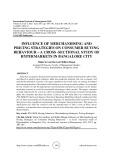
http://www.iaeme.com/IJM/index.as 180 editor@iaeme.com
International Journal of Management (IJM)
Volume 8, Issue 3, May– June 2017, pp. 180–189, Article ID: IJM_08_03_020
Available online at
http://www.iaeme.com/ijm/issues.asp?JType=IJM&VType=8&IType=3
Journal Impact Factor (2016): 8.1920 (Calculated by GISI) www.jifactor.com
ISSN Print: 0976-6502 and ISSN Online: 0976-6510
© IAEME Publication
INFLUENCE OF MERCHANDISING AND
PRICING STRATEGIES ON CONSUMER BUYING
BEHAVIOUR – A CROSS -SECTIONAL STUDY OF
HYPERMARKETS IN BANGALORE CITY
Shilpa Sarvani Ravi
and Shikha Bhagat
Assistant Professors, Faculty of Management Studies,
PES University, Banashankari, Bangalore, India
ABSTRACT
India has occupied a third position among emerging and developed nations after China
and Brazil in global retail rankings. India has moderate political risk, low economic risk
and market potential. Country’s has quite significant net retail sales are among developed
and emerging nations. The global retail business is evolving on a faster phase, it is essential
for the retailers to opt the appropriate merchandising and pricing strategies in the Indian
marketing scenario to avail the sustainable advantage in their market. This paper, attempts
to study empirically the extent to which merchandising and pricing strategies formulated,
affect the consumer purchase decisions. A Survey of 366 valid data was examined using
PLS-SEM (Partial Least Squares Structural Equating Modelling). Results emphasised that
the (1) Stock Availability (2) Promotional Signage (3) Standardized Discounts (4) Festival
Sale factors have significant relationship with consumer buying behaviour. This paper has
implications for both the retailers and the manufactures to take a note of these above
variables, to formulate their strategies and tactics for delivering value to the consumers in
Retail Outlets.
Key words: PLS-SEM, Buying behaviour, Merchandising Strategies, Pricing Strategies.
Cite this Article: Shilpa Sarvani Ravi and Shikha Bhagat, Influence of Merchandising and
Pricing Strategies on Consumer Buying Behaviour – A Cross -Sectional study of
Hypermarkets in Bangalore City. International Journal of Management, 8(3), 2017, pp.
180–189.
http://www.iaeme.com/ijm/issues.asp?JType=IJM&VType=8&IType=3





















